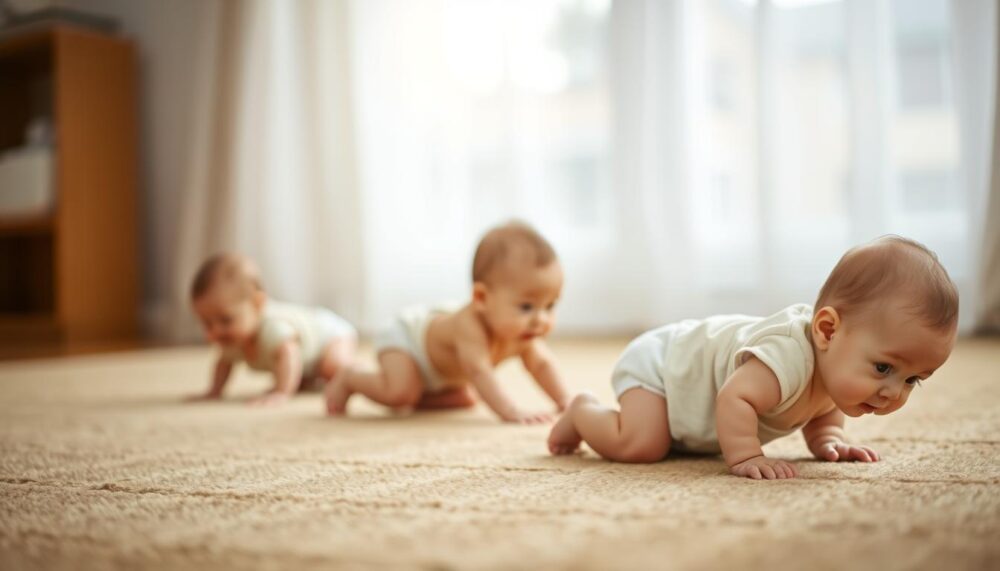Babies start crawling at different times. Most begin between 6 and 10 months old. Parents often wonder, when do babies start crawling?
This milestone is a big step in mobility and exploration. While many babies crawl around 9 months, timing varies based on individual growth.
The question when do babies crawl reflects parents’ curiosity about their child’s development. Crawling isn’t just about moving—it builds strength, coordination, and confidence. This article explains what to expect as your baby approaches this stage.
Key Takeaways
- Crawling typically starts between 6 and 10 months.
- Every baby’s timeline is unique; some may crawl earlier or later.
- Crawling boosts physical and cognitive skills.
- Signs like reaching for toys or rocking on hands signal readiness.
- Consult a pediatrician if concerns arise about developmental delays.
Understanding Baby Mobility Milestones
Every baby’s journey to moving around is special. Knowing when does infant start crawling or what age do babies crawl helps parents see progress. These milestones show growth in strength, curiosity, and thinking.

The Importance of Crawling in Development
- Strengthens muscles needed for walking
- Sharpens hand-eye coordination and balance
- Encourages exploration, boosting problem-solving skills
Crawling is more than just moving. It’s a way for babies to learn and grow. It helps them understand how to reach for things across the room.
Common Mobility Progression Patterns
- Head control (2–4 months)
- Sitting with support (5–7 months)
- Creeping or crawling (6–10 months)
- Pulling up to stand (9–12 months)
Most babies follow this order, but timing can vary. Some might scoot instead of crawl, or skip crawling altogether. This is okay as long as they’re moving forward.
Individual Differences in Development
Some babies start crawling at 6 months; others take longer. Genetics, environment, and personality influence this. It’s not helpful to compare your baby to others. Instead, watch for steady progress.
If milestones are delayed, talk to a pediatrician. But remember, every child grows at their own pace.
When Do Babies Start Crawling: Typical Timeline
Most babies start crawling between 6 and 10 months. This can vary a lot. Parents often ask when do babies start crawling and what age do babies crawl. Let’s look at this timeline to help.

The 6-10 Month Window
About 80% of babies start crawling between 6 and 10 months. By 6 months, many can rock on hands and knees. By 9 months, most can move in a crawling motion.
This range shows the usual what age do babies crawl times. Doctors say it’s normal for babies to progress at their own pace.
Early Crawlers vs. Late Bloomers
- Early crawlers (before 6 months): They often have strong arms and legs. But, always check for balance and coordination.
- Late bloomers (after 10 months): They might sit or stand first. If other skills grow well, it’s okay if crawling is late.
Both early and late crawlers are normal and healthy. As long as babies are active and curious, it’s fine.
Signs Your Baby Is Getting Ready to Crawl
Look for these signs before crawling starts:
- Rocking back and forth while on hands and knees
- Reaching for toys while in a hands-and-knees position
- Shifting weight side-to-side or backward-forward
These signs mean your baby is getting ready to crawl.
Pre-Crawling Movements to Watch For
Before babies start crawling, they practice important skills. These skills are key for when do babies start crawling. Each step helps build muscles for moving on their own.

- Tummy Time Progress: Lifting the head and chest while on their stomach builds neck and arm strength.
- Rocking on Hands and Knees: Shifting weight while on all fours prepares joints and balance.
- Forward Scooting: Some babies propel themselves backward or sideways before moving forward.
- Bear Crawling: Pushing up onto legs and arms to “walk” on hands and feet.
These movements may seem uncoordinated at first. But they are vital. When does infant start crawling depends on mastering these steps. Rocking or scooting backward are normal phases.
Parents should encourage tummy time daily to support this progression. Avoid forcing movements—each child’s timeline is unique. Watching for these signs helps track development without rushing the process. Celebrate small steps as part of the journey toward mobility.
When Do Babies Start Rolling Over
Rolling over is a big step for babies. Parents wonder when do babies start rolling over and what age do babies roll over. These movements are key to crawling and exploring. Let’s look at the stages and why they matter.
Back-to Front Rolling Milestones
Most babies roll from back to front between 4 to 6 months. They need strong neck, shoulder, and belly muscles. Tummy time helps build this strength.
Front to Back Rolling Development
Rolling from front to back starts a bit earlier, around 3 to 4 months. This is easier because gravity helps. Babies might rock or twist before mastering full rolls.
Connection Between Rolling and Crawling Skills
Rolling and crawling use the same muscles. Rolling helps build the coordination for crawling. When babies roll, they practice moving like they will when crawling.
Every baby grows at their own pace. If rolling is late, talk to a doctor. Celebrate every small step towards big milestones!
Different Crawling Styles and Techniques
When do babies start crawling? Every child finds their own way to move. Here’s a look at the unique styles you might see:
Classic Hands-and-Knees Crawling
This cross-pattern movement—alternating arms and knees—builds coordination. It’s common by 9-12 months. It strengthens muscles and brain connections needed for walking.
Army Crawl and Belly Crawling
Babies in the army crawl drag themselves forward on elbows and toes, belly low to the ground. Some stay close to the floor longer, gaining strength and spatial awareness.
Scooting, Crab Crawling, and Other Variations
- Scooting: Sliding on bottoms, often seen in kids with tight leg muscles.
- Crab Crawling: Moving sideways to reach toys, building hip flexibility.
- Bear Walking: Hands and feet on the ground, knees raised like a bear.
When do babies crawl? Timing varies, but creativity in movement is normal. Side-to-side crab crawls or backward scoots all count as progress. Focus on exploration, not perfection—each style helps prepare for walking.
No single method is “correct.” Celebrate any safe way your baby moves toward their goals. These motions boost problem-solving and confidence, proving every path to mobility matters.
Factors That Influence When Babies Begin Crawling
Every baby’s journey to crawling is unique. Understanding these factors helps parents see why when do babies start crawling changes so much. Let’s look at the main things that shape this important milestone.
- Physical readiness: Muscle strength and body shape play a big role. Babies with stronger cores and better flexibility tend to move sooner.
- Environment: Having safe spaces and encouragement helps. Cultural practices like tummy time also affect timing.
- Temperament: Curious or determined babies might rush to crawl to explore. Others might take it slower and be more cautious.
- Prematurity: Use corrected age for preemies. Their development matches adjusted months, not just birth age.
- Family history: If your family has early crawlers or walkers, it might be genetic. Sibling milestones can hint at inherited traits.
Understanding these factors helps parents not worry about comparing their child to others. While most babies crawl between 6–10 months, it’s okay if they don’t. Support your baby’s own pace with safe play areas and patience. Always talk to a pediatrician if you’re worried about delays.
How to Support and Encourage Crawling Development
Supporting your baby’s crawling journey starts with creating safe spaces for exploration. Parents can help by focusing on key strategies. These steps help nurture curiosity while respecting each baby’s unique development pace.
Tummy Time Importance and Techniques
Start tummy time by 2 months to build neck and shoulder strength. Begin with 3-5 minutes daily, increasing to 1-2 hours by 6 months. Tips to engage resistant babies:
- Place black-and-white toys or mirrors within reach
- Lie face-down over your chest during bonding time
- Use soft mats or blankets for comfort
Creating an Exploration-Friendly Environment
Design a safe zone with open floor space free of small objects. Use play yards or gated areas. Avoid restrictive items like bouncers for extended periods. Key adjustments:
- Use textured rugs to encourage grip
- Remove furniture with sharp edges
- Keep floors clear for free movement
Toys and Activities That Promote Crawling
Position rattles or stuffed animals just beyond baby’s reach. Use tunnels, push-along toys, or musical toys to spark curiosity. Try these activities:
- Baby-proofed obstacle courses with pillows
- Roll balls across the floor to follow
- Interactive floor gyms with hanging toys
Each step should align with your baby’s readiness—celebrate small progress toward when does infant start crawling.
Crawling Safety: Preparing Your Home
Knowing when do babies start crawling? varies, but safety preparations should start long before your baby’s first moves. When do babies start rolling over? also signals it’s time to secure spaces—they can transition quickly from rolling to exploring upright. Begin baby-proofing by month 4 to 6 to stay ahead of their rapid development.
- Secure furniture: Anchor dressers, TVs, and bookshelves to walls to prevent tipping.
- Outlet covers: Block electrical outlets and tuck cords out of reach.
- Choking hazards: Remove small items like coins, buttons, or magnets from floors and low surfaces.
- Stair gates: Install pressure-mounted or hardware-mounted gates at stairways.
- Pet areas: Keep pet food bowls, litter boxes, and toys out of crawling paths.
Get on your hands and knees to spot hazards at their eye level. Move toxic products, cleaning supplies, and medications into locked cabinets. Secure windows with safety latches and guards. Regularly inspect floors for stray items—babies explore by touching and mouthing objects. Safety measures protect them as they gain mobility, whether they crawl, roll, or scoot.
Pro tip: Check CPSC guidelines for certified safety products. Ongoing vigilance ensures a safe environment as they progress from rolling to crawling.
What If My Baby Skips Crawling?
Every baby’s journey is unique. While most start crawling between 6-10 months, some find their own ways to explore. Parents often wonder, “when does infant start crawling?” But, shuffling or cruising can be perfectly normal.
Bottom Shufflers and Furniture Cruisers
Some babies scoot on their bottoms, using legs to push while seated. Others pull themselves along furniture edges, a behavior called “cruising.” These methods let infants move without traditional crawling. Shuffling helps build core strength, while cruising strengthens leg muscles for walking.
From Sitting to Standing: Alternative Paths
Some skip crawling entirely, moving directly from sitting to pulling up on objects. This path doesn’t delay walking—many babies bypass crawling and walk by 12-14 months. Focus on your baby’s overall progress, not just crawling.
When to Consult With Your Pediatrician
Seek advice if your baby shows:
- No crawling or shuffling by 12 months.
- Limited interest in moving toward objects.
- Uneven use of arms or legs during movements.
Early checks ensure any concerns are addressed promptly. Most cases are harmless, but a professional can confirm if support is needed.
The Developmental Benefits of Crawling
Crawling and rolling over are more than just ways to move. They help build strength and improve thinking skills. When babies crawl, they get stronger in their arms, legs, and core. This is important for walking and climbing later.
Rolling over, which usually happens first, helps babies control their neck and shoulders. This is the first step to crawling.
- Physical Growth: Crawling builds coordination and balance, preparing bodies for future motor skills.
- Cognitive Boost: Navigating paths teaches spatial awareness and problem-solving, like figuring out how to reach a toy.
- Brain Development: Cross-body crawling motions may improve hand-eye coordination, aiding skills like writing or catching objects.
Rolling over, which often starts around 4-6 months, also supports head control and body awareness. Even if a baby skips crawling, activities like tummy time or exploring on their feet can build similar skills. The timing of these milestones varies—some roll earlier, others crawl later—but the benefits come from active exploration.
These movements help babies process sensory input, like textures and distances, while strengthening neural connections. While the when do babies crawl and what age do babies roll over can vary, the act of moving independently fuels learning. Encourage safe play spaces to let them discover their world at their own pace.
When to Be Concerned About Crawling Delays
Most babies roll over between 4-7 months and start crawling by 10 months. But, some patterns might mean there’s a deeper issue. Here’s how to spot signs that need attention.
Red Flags in Motor Development
See a doctor if your child:
- Hasn’t rolled by 9 months (rolling usually starts at 4-6 months)
- Isn’t crawling by 12 months (crawling usually starts around 9 months)
- Has stiff or floppy limbs or drags one side of the body
- Stops skills they once had, like sitting or reaching
Understanding Developmental Screening
Screenings check motor progress through:
- Age-based checkups at 9, 18, and 24 months
- Observing muscle tone and movement
- Parent-reported milestones and family history
Use a simple tracker to follow developmental landmarks:
| Milestone | Typical Range |
|---|---|
| Rolling Over | 4-7 months |
| Crawling | 6-10 months |
| Combining Skills | Walking by 15 months |
Talk to your pediatrician about delays. Early screening helps address needs and avoid overthinking natural variations.
Conclusion: Supporting Your Baby’s Unique Journey
Babies crawl at their own pace, with most starting between 6 and 10 months. But, the exact time can vary a lot. Some might roll, scoot, or shuffle before crawling, and each step is important for their growth.
Make sure your baby has safe places to explore, like floor time and toys that are right for their age. This helps them move freely without feeling rushed. Celebrate every small achievement, like reaching for toys or changing positions. These moments help build their confidence and strength.
Don’t worry if your baby doesn’t crawl right away. Some might go straight to walking, while others find their own ways to move. If you’re worried about your baby’s progress, talk to a pediatrician. Every baby grows at their own speed, and that’s okay.
Enjoy this time, as crawling often leads to walking soon. By supporting your baby’s unique journey, you help them become curious and resilient. This sets them up for a lifetime of exploration and learning.
FAQ
When do babies start crawling?
Babies usually start crawling between 6 to 10 months. But, some might start as early as 5 months or as late as 11 months.
What age do babies roll over?
Babies learn to roll over from back to front around 4 to 6 months. They can roll from front to back between 3 to 4 months. These skills help them get ready to crawl.
What age do babies crawl?
Babies start crawling between 6 to 10 months. Each baby develops at their own pace.
When do babies start rolling over?
Babies start rolling over between 3 to 6 months. Most master the back-to-front roll by 6 months.
What are the signs that my baby is getting ready to crawl?
Signs include pushing up on hands and knees, rocking back and forth. They also want to reach for toys or objects just out of reach.
How does rolling contribute to crawling skills?
Rolling develops muscles needed for crawling. It’s a key milestone for later mobility skills.
Are there different styles of crawling?
Yes, babies crawl in different ways like hands-and-knees, army crawling, or scooting. Each style is normal and helps with mobility.
What factors influence when babies begin crawling?
Factors include muscle tone, weight, and floor time. Temperament, like curiosity, also plays a role.
What can I do to support my baby’s crawling development?
Give your baby lots of tummy time. Make their environment safe for exploration. Use toys that encourage movement.
How can I baby-proof my home for a crawling infant?
Secure furniture, cover outlets, and remove hazards. Use safety gates on stairs to keep your baby safe.
What if my baby skips crawling altogether?
Some babies go straight to scooting or standing. If worried, talk to your pediatrician for advice.
When should I be concerned about crawling delays?
If your baby shows uneven movement or lacks interest in moving by 12 months, see a healthcare provider.








